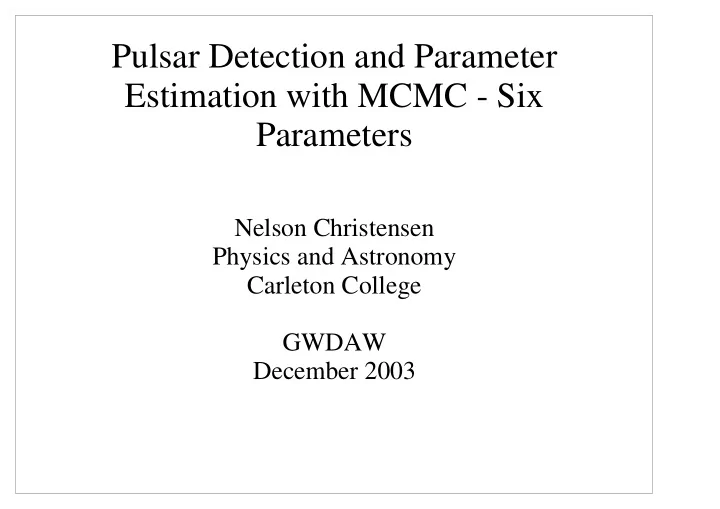

Pulsar Detection and Parameter Estimation with MCMC - Six Parameters Nelson Christensen Physics and Astronomy Carleton College GWDAW December 2003
Collaborators Rejean Dupuis, John Veitch, Graham Woan Department of Physics and Astronomy Glasgow University Renate Meyer, Richard Umstaetter Department of Statistics University of Auckland
� � � � � Markov Chain Monte Carlo Computational Bayesian Technique Metropolis-Hastings Routine Estimate Parameters and Generate Summary Statistics (PDFs, cross correlation, etc) 6 Unknown Parameters (so far): h 0 , ι, ψ, φ, δ f, df/dt Initial Application SN1987a: Location known but other parameters not
Starting Point The Starting point for the MCMC is the same likelihood and priors used in the LSC time domain (bayesian) search Remember Rejean's talk
� ✁ ✆ ☎ ✄ ✂ Time domain method (Rejean) • The phase evolution can be removed by heterodyning to dc. – Heterodyne (multiply by e -i Φ (t) ) calibrated time domain data from detectors. – This process reduces a potential GW signal h(t) to a slow varying complex signal y(t) which reflects the beam pattern of the interferometer. – By means of averaging and filtering, we calculate an estimate of this signal y(t) every 1 minute which we call B k . The B k ’s are our data which we compare with the model 1 i cos 2 i e i 2 i 2 t h 0 1 h 0 cos i e 0 0 y t 4 F 2 F X t
☎ ☎ ✆ ✝ � ✁ ✝ ✄ � ✂ ✁ � ✞ Bayesian analysis (Rejean) A Bayesian approach is used to determine the joint posterior distribution of the probability of the unknown parameters, a =(h 0 ,ι,φ,ψ,δ f,df/dt), via the likelihood: Model 2 B k y t k ; a exp p B k a 2 2 k k Noise estimate B k ’s are processed data p p a B k a p B k a Prior Likelihood Posterior
Metropolis Hasting Routine Generate a chain of parameter values PDFs generated from the distribution of chain values Quasi-Random (somewhat intelligent) walk through parameter space
4 or 5 parameter search is straightforward h 0 , ι, ψ, φ , δ f 6 th parameter df/dt causes problems Distributions for δ f and df/dt are VERY narrow Hard to find
Reparametrization New Variables f start = δ f + (1/2)(df/dt)T start f end = δ f + (1/2)(df/dt)T end
S2 Injected Signals: Analysis using a Metropolis-Hastings Markov chain Monte Carlo Routine Here we present results for analysis of signals injected during S2.
Injected Signal Parameters Signal 2: Unknown Parameters of Injected Signal: h0 = 20.0 (± calibration errors, in some units) ψ = 0.0 φ = 0.0 cos( ι )=0.0 df/dt = -5.0e-9 Rejean put in an offset in a δ f to make it non-zero. δ f = 6.17e-4 H1 signal 524 minutes of data, 458 minutes for H2, and 394 minutes for L1.
One Parameter Hiccup Parameter of the phase φ : Injected with wrong phase (- π/2 ), and with factor of 2 for gravity wave this resulted in an effective value of φ = - π /4
H1 Parameter Estimation Result
H1 Parameter Estimation Result
H1 Parameter Estimation Result Quantiles for each variable: 97.5% 2.5% Mean h0 2.41e+01 h0 1.55e+01 h0 1.99e+01 psi 8.37e-02 psi -1.17e-01 psi -1.62e-02 phase -2.96e-02 phase -1.40e+00 phase -7.495e-01 cosiota 1.82e-01 cosiota -9.12e-02 cosiota 4.20e-02 df 6.31e-04 df 6.06e-04 df 6.19e-04 dfdot -4.48e-09 dfdot -5.66e-09 dfdot -5.09e-09
H2 Parameter Estimation Result
H2 Parameter Estimation Result
H2 Parameter Estimation Result Quantiles for each variable: Mean 2.5% 97.5% h0 1.71e+01 h0 1.13e+01 h0 2.34e+01 psi -1.63e-02 psi -1.90e-01 psi 1.31e-01 phase -7.09e-01 phase -1.48e+00 phase 5.00e-01 cosiota 4.01e-02 cosiota -2.02e-01 cosiota 2.69e-01 df 6.19e-04 df 5.95e-04 df 6.34e-04 dfdot -5.09e-09 dfdot -5.83e-09 dfdot -3.94e-09
Tested Code on Synthesized Data δ f 0.007 Hz df/dt -2.5e-10 d 2 f/dt 2 0.0 h0 “varied” 0.4 ψ 1.0 φ 0.5 ι RA 1.23 DEC 0.321 10 days worth of data Noise σ k = 1.0
Estimate of h 0
Estimate of df
Estimate of df/dt
Goal of our Work SN1987a Location known, but all other parameters unknown. Heterodyne 1/60 Hz bandwidth: 5 Hz search with 300 processes. Also useful for radio observed pulsar: work in concert with time domain search. John Veitch (Glasgow) is presently running code on E10 and S3 injections.
Delayed Rejection
ABSTRACT Presented is a Markov chain Monte Carlo technique for finding a laser interferometer detected pulsar signal and estimating 6 unknown parameters, including the pulsar frequency and frequency derivative. The technique used is called Delayed Rejection in Reversible Jump Metropolis-Hastings. This method will be explained, as well as noting how a simple extension to multiple computer processors will allow for a wider frequency band search. The goal of this research is to search for a possible (but radio quiet) source at a know location; for example, SN1987A. The code has been successfully demonstrated with synthesized data, and with LIGO S2 injected signals. The results of the code on these artificial signals will be presented.
The Details of the Technique This talk will describe the details of how the 6 parameter MCMC search works. However, I have not written this yet. The results of the technique using S2 injected signals are presented here for LSC review. Results on synthesized and ficticious data are not included here (but will eventually make it into the talk).
Recommend
More recommend